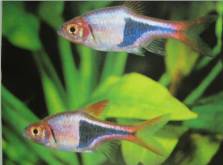Harlequin Fish
Genus name: Trigonostigma (Rasbora) Heteromorpha
Also known as: Harlequin Rasbora, Red Rasbora
Distribution: Thailand, Malay Archipelago, Indonesia
Length: up to 1.8″ (4.5cm)
Minimum Tank Length: 12″ (30cm)
Water Temperature: 72-77F (22-25C)
Diet: small crustaceans, insects, dried food, worms
Water: soft and slightly acidic water
Lives: upper areas of the aquarium
Breeding: Egg Layer
The Harlequin is an old favourite, it was introduced to aquariums as long ago as 1906. Harlequins are peaceful, non-aggressive fish, and are ideal for a community aquarium of like-minded fish.
Harlequins are stockier than other varieties of Rasbora, but the male is noticeably more slender than the female. In general Harlequins are a silvery colour, the back is bright pink to violet, and the flanks are a more delicate pink. The underparts are a pale silvery-white.
The most striking feature of the Harlequin is the wedge-shaped blue-black marking on the rear half of the body. In the male this marking is sharply defined and its lower, front edge reaches down to the centre point of the belly. In the female Harlequin this marking has a much hazier outline and it does not extend as far as the belly.
Harlequins should be kept in a shoal of at least eight to ten fish if possible, and in an aquarium with areas of dense vegetation arranged to leave sufficient space for swimming. Harlequins mainly swim at the top of the aquarium.
Many Rasboras breed fairly easily in home aquariums, but unfortunately the Harlequin is not one of these. When it does happen, the pair of Harlequins will lie upside down under a leaf or similar, and the male will curl his tail around the female.
The eggs hatch in 26 to 30 hours, and the fry are free-swimming three to five days later. As with many tropical fish, Harlequins are not good parents and will eat their eggs if given the chance.

